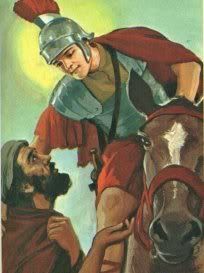November 11 - St. Martin of Tours

NOVEMBER 11
ST. MARTIN OF TOURS
This soldier saint lived in the fourth century. He joined the Roman army in Italy when he was only fifteen. Although his parents were pagans, he began to study the Christian religion. Those who study the Christian religion are called catechumens until they are baptized.
One very cold winter day, Martin and his companions came upon a beggar at the gate of the city of Amiens. The man's only clothes were nothing but rags and he was shaking with cold. The other soldiers passed by him, but Martin felt that it was up to him to help the beggar. Having nothing with him, he drew his sword and cut his long cloak in half. Some laughed at his funny appearance as he gave one half to the beggar. Others felt ashamed of their own selfishness. That night, Jesus appeared to Martin. He was wearing the half of the cloak that Martin had given away.
"Martin, still a catechumen, has covered me with this garment," Jesus said. Right after this wonderful event, St. Martin went to be baptized. A few years later, the saint left the army. He became a disciple of St. Hilary, the bishop of Poitiers, France. Because of his strong opposition to the Arian heretics in various cities, Martin had to go into exile. But he was happy to live in the wilderness with other monks. When the people of Tours asked for him as their bishop, he refused. The people would not give up, however. They got him to come to the city to visit a sick person. Once he was there, they took him to the church. As bishop of Tours, St. Martin did all he could to rid France of paganism. He prayed, he worked, he preached everywhere.
Our Lord let Martin know when his death was near. As soon as his followers heard of it, they began to weep. They begged him not to leave them. So the saint prayed: "Lord, if your people need me yet, I will not refuse the work. Your will be done." He was still laboring for the Divine Master in a far-off part of his diocese when death finally came in 397. St. Martin's tomb became one of the most famous shrines in all of Europe.


0 Comments:
Post a Comment
<< Home